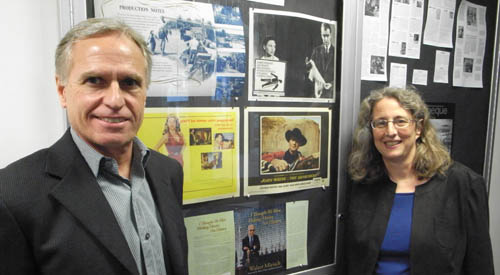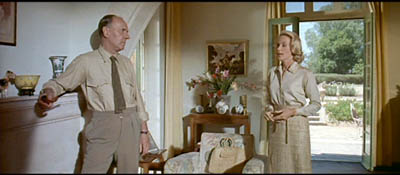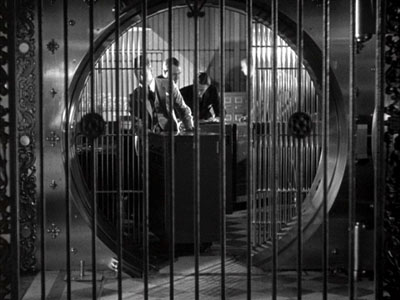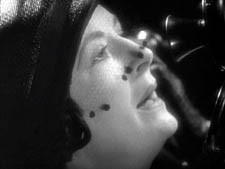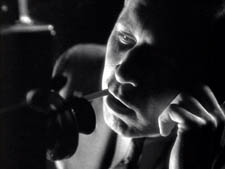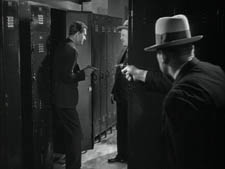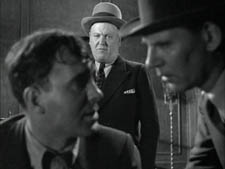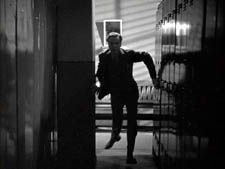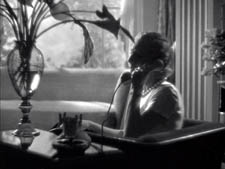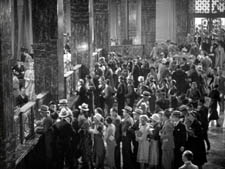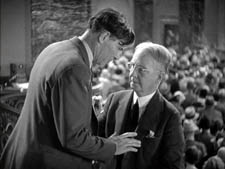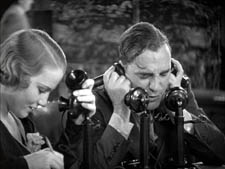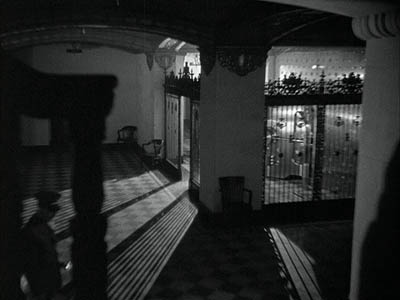American (Movie) Madness
Saturday | June 14, 2008 open printable version
open printable version
Grover Crisp and Lea Jacobs outside the University of Wisconsin–Madison Cinematheque.
DB here, again:
He holds sway over thousands of movies and the transfer of hundreds of DVDs. At home he has a high-definition set, but he gets local channels on a rabbit-ears antenna. If that isn’t a working definition of a Film Person, I don’t know what is.
Over the years our UW Film Studies area has hosted many visiting Film Persons, including archivists Chris Horak, Mike Pogorzelski, Joe Lindner, Schawn Belston, and Paolo Cherchi Usai. (1) Being a department centrally interested in film history, we’re eager to screen recent restorations and learn the ins and outs of film archivery.
This year our Cinematheque screened several Sony/ Columbia restorations, running the gamut from Anatomy of a Murder to The Burglar. We wound up our series, and our season, with a stunning print of Frank Capra’s American Madness (1932). To conclude things with a bang, Lea Jacobs, Karin Kolb, and Jeff Smith brought Grover Crisp, Sony’s Senior Vice President of Asset Management, Film Restoration, and Digital Mastering.
Kristin and I had met Grover at the Cinema Ritrovato festival in Bologna, and after hearing him introduce some restorations, we knew he had to come to Madison. It was a Bologna screening of American Madness that convinced me that we had to show this sparkling print on our campus. Fortunately for us, Grover squeezed a Madison visit into his schedule and suffered the caprices of American Airlines’ delays. We had about two days of his company.
It was a great learning experience. On Thursday 8 May he addressed our colloquium, where he showed two shorts: a 1933 Screen Snapshots installment explaining the process of motion picture production, from script to final product, and a trim 75-second short by his colleague Michael Friend tracing the evolution of filmmaking technology. On Friday Grover introduced American Madness and took questions.
Just a note about terminology: Archives engage in both film preservation and film restoration. Preservation means, as you’d think, saving films for the future. This involves maintaining the materials (prints, negatives, camera material, sound tracks) in surroundings that minimize harm and deterioration. Restoration demands more resources. It involves trying to create an authoritative version of the film as it existed in some earlier point in history. But that’s a complicated matter, as we’ll see.
Archives and assets
Grover brings a Film Person’s sensitivity to the mission of film preservation. What does that mean? For one thing, he takes the long perspective. Film archivists think about how to store and maintain films for decades, even hundreds of years. In an industry geared to short-term cycles, booms and busts and jagged demand curves, a commercial archivist like Grover, or Schawn of Fox, has to reconcile traditional museum standards with market demands, strategic release considerations, and current studio policies. In short, he has to think both about saving the film for a century and about hitting a DVD street date.
Grover explained his obligations at Sony Pictures Entertainment. He manages all film and television materials. That means preserving everything for any future use and restoring some items for video and theatrical screening. It also means that he keeps abreast of current TV and film productions. This gives him a chance to “embed archival needs” into production and postproduction processes. For example, from 1991 to the present, YCM separation masters are prepared for every film. (2) And today, when a film is finished and output digitally onto a negative for release prints, another negative is assembled from the camera negative, the most pristine source, and that goes into cold storage.
Grover supervises a staff of about twenty-five people, six of whom are overseeing film laboratory and audio work full-time. Unlike other studio archives, Sony does not hand off preservation tasks to outside companies. Being a Film Person, Grover asks that for films a new negative be created, and fresh screening prints be prepared.
What impelled a big company like Sony to invest so much in preservation and restoration? Grover explained that the rise of home video taught most studios that their libraries had some value. In particular, executives were impressed by Ted Turner’s 1986 purchase of MGM for its library, which he could recycle endlessly on TBS. They realized that the libraries were genuine assets. Old movies enhanced the firm’s value (if it were to be sold, as many were in those days) and could be exploited through new media platforms, like cable.
The arrival of DVD made all the studios return to their libraries to make high-quality versions of their top titles. Now the high-definition format of Blu-ray will re-start restoration because of the leap in quality it offers.
Sony moved early, partly because it understood new media. When Sony bought Columbia Pictures in 1989, the Japanese executives envisioned a synergy between Sony’s hardware and a movie studio’s software. “One of the first things they asked,” Grover recalls, “was, ‘What’s the condition of the library?’” Soon afterward, Sony set up the first systematic collaboration between studio archivists and museum-based archivists. The Sony Pictures Film Preservation Committee included archivists from Eastman House, the Library of Congress, UCLA, MoMA, the Academy, and other institutions. In addition, Grover modeled Sony’s restoration policies on the exemplary work of legendary UCLA archivist Bob Gitt (whose work on sound restoration we’ve already saluted in another entry).
Digital restoration has been part of the Sony program. The 1997 restoration of Capra’s Matinee Idol (1927), from a Cinémathèque Française print, was the first live-action high-definition restoration from any studio.
Sony holds between 3600 and 5000 titles. It’s impossible to be more precise at this point because in hundreds of cases the rights situation is uncertain. But of the core library, about half to two-thirds of the films are restored. Crisp’s team is at work on about 200 titles at any moment! Many more are restored than warrant DVD release, but they may be available On Demand and via TCM, which has recently acquired cablecast rights to several older Columbia titles.
Restore, yes! But what, and how?
We’re grateful for preservation, but for cinephiles, restoration holds a special thrill. A “restored” Intolerance or Napoleon or von Sternberg movie gets us salivating. This year Cannes ran nine restorations on its program.
But what is a restoration?
We expect that a restoration will provide a film with a better-quality image or soundtrack than we’ve had so far. We often expect as well that a restoration will provide a more complete version of the title. Yet there are problems with both expectations.
First, who’s to say what the quality of the original is? Grover encountered this difficulty in restoring Funny Girl. It was released in the classic Technicolor dye-transfer process, usually considered the gold standard for color cinematography. He assembled five original Technicolor prints and all of them looked different. It turns out that Technicolor prints varied quite a bit. (3) The kicker was that Grover couldn’t make the new dye-transfer 35mm print of Funny Girl match any of these reference prints. That didn’t stop it looking fabulous when it premiered in LA.
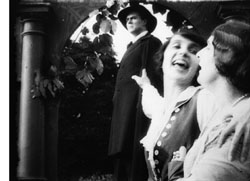 What about restoration that adds footage to an existing version of a movie? My previous blog entry mentioned an example, the wild and crazy Nerven (1919), to be issued on DVD by the Munich Film Museum. Stefan Drössler, Munich’s curator, has done a remarkable job of incorporating new footage into the longest version of Nerven to date. (The new material includes “living intertitles,” in which actors drape themselves around gigantic letters.) But Nerven remains incomplete, lacking about a third of its original material.
What about restoration that adds footage to an existing version of a movie? My previous blog entry mentioned an example, the wild and crazy Nerven (1919), to be issued on DVD by the Munich Film Museum. Stefan Drössler, Munich’s curator, has done a remarkable job of incorporating new footage into the longest version of Nerven to date. (The new material includes “living intertitles,” in which actors drape themselves around gigantic letters.) But Nerven remains incomplete, lacking about a third of its original material.
Moreover, it’s possible to “over-restore” a film. That is, by adding footage culled from many versions, the restorer may be creating an expanded version that nobody actually saw.
Original version? What does that mean? Paolo Cherchi Usai has reflected on this at length. (4) Is the original what the film was like on initial release? This is tricky nowadays for new titles, because as Grover pointed out, most films are “initially released” in several versions. Since Hollywood filmmaking began, different versions have been made for the domestic and the overseas markets, and often the overseas versions are longer. Sometimes a film opens locally or at a film festival and then is modified for release. Major films by Hou Hsiao-hsien and Wong Kar-wai have played Cannes in versions longer than circulated later.
Now suppose that the film was modified by producers or censors for its initial release somewhere. If you can determine the filmmaker’s wishes, should you restore the film to what she or he wanted it to be? That flouts the historical principle of getting back to what people actually saw. Consider the shape-shifting Blade Runner. Only now, twenty-five years after its release, has the U. S. theatrical version appeared on video.
Or what do we do when a filmmaker, after the release, decides that the film needs to be changed? Late in life, Henry James felt the urge to rewrite many of his novels, and the revised versions reflect his mature sense of what he wanted his oeuvre to be. Why can’t a filmmaker decide to recast an older film? Such was the case with Apocalypse Now Redux and Ashes of Time Redux. Since the later version represents the artist’s latest viewpoint, should that be the authoritative version?
Grover encountered a variant of this problem when he invited one cinematographer to help restore a film. The cinematographer’s own aesthetic and approach to his work had evolved over the years, so he started to tweak things in a way that was taking the look of the film to a level much different than the original achievement. Grover had to steer him back to respecting the film’s original look.
On the brighter side: Grover brought in master cinematographer Jack Cardiff to advise on the restoration of A Matter of Life and Death. Cardiff said that one scene needed a “more lemony” cast. Grover tried, but each time Cardiff said it wasn’t right. Finally, Grover confessed that he just couldn’t get that lemony look. Cardiff nodded. “Neither could I.”
Grover offers this nugget of wisdom: It is almost impossible to get an older film to look the way it does when it was originally released. The color will never look as it did, nor will sound sound the way it did. Film stocks have changed, printing processes have changed, technology in general has changed. Every version is an approximation, though some approximations may be better than others. Take consolation in the fact that even when the movie was in circulation, it may have already existed in multiple versions.
What do consumers want?
All archivists explain that compromises enter into the preservation process down the line. One of the revelations of Grover Crisp’s visit was the awareness of just how many of these compromises come into play, and how some of them are tied to what DVD buyers expect.
Many films from Hollywood’s studio era are soft, low-contrast, and grainy. Project a 1930s nitrate copy today, and though it will be gorgeous, it’s likely to look surprisingly unsharp. Things apparently didn’t improve when safety stock came along in the late 1940s; projectionists complained that those prints were even softer and harder to focus than nitrate ones. As recently as the 1970s, films were not as crisp as we’d like to think. I’ve examined the first two parts of The Godfather on IB Tech 35mm originals, and though they look sharp on a flatbed viewer, in projection the grains swarm across the screen like beetles. (I should add that many of today’s films also look mushy and grainy in the release prints I see at my local.)
But I think that DVD cultivated a taste for hard-edged images, perhaps in the way that music CDs cultivated a taste for brittle, vacuum-packed sound. It’s not surprising, then, that video aficionados are often startled when a DVD release of a classic movie looks far from clean. This is not always attributable to a film’s not being cleaned up to the fullest extent the technology allows. Some films are inherently grainy, gritty, or soft-looking. With the advent of Blu-ray and HD imagery for the home, those films’ look is often mistaken for problems with the transfer, or signs that the distributor didn’t care enough to spend the money to thoroughly make it new. “New” in this case means contemporary.
So there are compromises, according to Grover, that the studios are having to deal with:
What do do about a film that is really grainy? Do you remove the grain, reduce the grain, leave the grain alone? Everyone seems to have a different answer, and it often puts the distributor in a difficult situation. These are questions that will be answered over time, as the consumer gets used to seeing images in HD that truly represent the way a film looks.
Another compromise involves sound. “Now you’re getting to an ethical area,” Grover remarks. In restoring early sound movies, Sony removes only clicks, pops, and scratchy noises (while still keeping the original, faults and all, as a reference). Sound problems are compounded in films from the early 1950s. Many releases at that time were shot in a widescreen process but retained monaural sound. Yet avid DVD buyers want multitrack versions to feed their home theatres. “If it’s not 5.1, we get complaints.” So Grover’s engineers “upmix” mono, as well as two-channel stereo, to 5.1—though they strive to keep the 5.1 minimal and retain as much authenticity as possible. Not on every film, of course: often the original mono track is included on the DVD.
On the positive side, Sony held the original tracks for Tommy (1975), originally released in Quintaphonic. (Old-timers will remember that audiophiles were urged to upgrade to this, and some LPs were released in that format.) Grover was pleased that he could replicate the theatrical version’s 5-channel mix on the DVD. (More details here.)
Now for a hobby horse of mine. The 1950s-1960s standards for multichannel sound were not those of today’s theatres. Today’s filmmakers funnel important dialogue through the front central speaker. But in multi-track CinemaScope and other widescreen formats, dialogue was spread to the left and right speakers as well, and these were behind the screen. That meant that a character standing on screen left was heard from that spot as well. (Remember, these screens might be seventy feet across.) Long ago Kristin and I saw an original 70mm release print of Exodus (shot in Super Panavision) in a big roadshow house in Paris. The ping-pong effect of the conversations between Ralph Richardson and Eva Marie Saint was fascinating.
Today, however, it might be distracting. In a home theatre, where discrete tracks present sound from offscreen left or right, it would seem downright weird. Although Grover didn’t comment on this, it’s clear that the big-screen classics from the magnetic-track era are remixed for DVD to suit current theatrical and home-video standards. This makes it very difficult for researchers to study the aesthetics of sound design from that period. Even if you visit an archive, that institution almost certainly isn’t able to project the film in a multi-channel version. (5) Is it too late to ask DVD producers to replicate, on a second soundtrack, the original channel layout? This would be a big favor to the academic study of the history of sound, and some home-theatre enthusiasts might develop a taste for the old-fashioned sonic field.
Last questions
Q: Do Grover and his colleagues take notice of online chat about DVD releases?
A: Yes, because it’s important to know what many participants in those conversations want from a film’s release, and they may also know things (from a hardcore fan’s pespective) about a film that is useful to know. Grover’s staff members can learn about missing scenes and other variant prints. But sometimes the Net writers are working from incomplete information and can get things wrong. A fan fervently announced that one word was intelligible in the “original” version of a film but not on the DVD. Yet the theatrical release version muffled the word. It turns out that the word was audible in a remixed TV version, which the fan had used as reference. Likewise, one critic who found the color on the Man for All Seasons Special Edition DVD too vibrant was evidently using a VHS version as the reference point. (For what it’s worth, the color in the Man for All Seasons theatrical release I saw was extremely vivid.) And Grover and his colleagues never intervene in the online debates.
Q: Why do DVDs seem different from projected prints—often much sharper?
A: An original film frame, in camera negative, has more resolution than can be captured in a print. Most prints are a generation or two past the material that a DVD transfer uses, so they gain a certain softness. Granted, however, in making high-definition video masters sometimes the tools to sharpen and de-grain the image are overused.
In addition, it’s generally a good idea to get your home video display calibrated. Most home displays are way too bright, sometimes brighter than a theatre screen. If you darkened the room and had the display dialed down, DVDs would look more film-like.
Q: When will we get the Boetticher westerns?
A: It’s the most frequent question Grover gets asked. Soon, soon: A boxed set of restored titles is on the way.
Q: And what about all the Capra titles?
A: Sony plans to restore each of them. Columbia struck many prints of them, and so there is some negative wear. Some negatives no longer exist. On one title, Say It with Sables (1928), Sony has neither negative nor prints.
There’s a too-good-to-be-true backstory here. Capra had a ranch in Pomona, which upon his death was bequeathed to Pomona State University. After some years, people found in a locked stable his private collection of prints struck in 1939. The cache included Lost Horizon, You Can’t Take It with You, It Happened One Night, and the best-quality print of Mr. Smith Goes to Washington Grover had yet seen. There were also photographs Capra had shot of premieres and vacations. Thanks to the good offices of Frank Capra, Jr., Sony acquired the prints and used them in its restorations.
As for American Madness, Grover called it a “training film” for later Capra productions. The theme of faith in the little man, manifested in a bank run that tests a humane banker’s alliances in the community, points ahead to It’s a Wonderful Life and other films. Sony holds a complete soundtrack and a nearly complete original negative. UCLA held a complete nitrate print donated by the Los Angeles Parks and Recreation Department; evidently the film was screened in parks as public entertainment. That print wasn’t in good condition, but it allowed Grover’s team to fill out certain scenes. The nitrate print’s footage is noticeably lighter and grainier in a few places. American Madness wasn’t a digital restoration, but if it were done today Grover would probably use CGI to blend in the alien footage.
Talkies, with a vengeance
It was fine to see the film again; its brisk inventiveness held up. The gleaming and geometrical images of the opening, which acquaint us with the daily routine of opening the bank vault, might have come out of Metropolis. One helter-skelter montage sequence, complete with canted framings and chiaroscuro lighting, looks forward to Slavko Vorkapich’s delirious contributions to Mr. Smith and Meet John Doe.
The tactics of depth composition that we find in many 1930s movies reappear here, and the illumination has dashes of noir.
I especially like the dynamic pans that carry Walter Huston and Pat O’Brien in and out of the main office; I suspect that they’re cut together faster and faster as the climax gets near. And the huge set of the bank lobby, publicized at the time as the biggest set yet built on the Columbia lot, remains not only impressive but functional. It establishes a cogent geography to which Capra adheres strictly while filming it from a great variety of angles.
But this is not a treat just for the eyes. American Madness flaunts its mastery of emerging talkie technique. The rising action is accentuated by the steady increase in volume of the growing crowd in the bank lobby. The clerks’ scattershot morning chat in the vault is captured in microphone distances and auditory textures that suggest a hollow, sealed-off space. Hawks’ rapid-fire patter in Twentieth Century (1934) has an antecedent here, and at the same studio. The actors speak at a terrific clip, scarcely pausing between lines, and sometimes the dialogue overlaps. We even get competing lines, two or more speeches rattled off at once. (And did Hawks get the idea for His Girl Friday’s variants on telephone chatter from O’Brien working the receivers at the climax?)
In films like this, American movies talk American. Consequently, I’m inclined to regard as an in-joke the glimpse we get of a marquee that’s advertising another Columbia picture: Hollywood Speaks.
Thanks to Grover and Sony Pictures Entertainment for a wonderful series and an enlightening brace of talks. American Madness is available on the DVD set The Premiere Frank Capra Collection.
(1) Chris Horak has been head archivist at George Eastman House, the Munich Film Museum, Universal, and the Hollywood Museum; he’s now Director of the UCLA Film & Television Archive. Mike Pogorzelski is Director of the Film Archive for the Academy of Motion Picture Arts and Sciences; Joe Lindner is Preservation Officer there. (Both are former Badgers.) Schawn Belston is Vice President of Asset Management and Film Preservation at Twentieth Century Fox. Paolo Cherchi Usai is Director of ScreenSound Australia, the national archive, and director of the recent film Passio. Kristin interviewed Mike and Schawn for this blog entry.
(2) YCM separation masters are made by copying a color film onto three black-and-white films. Thanks to filtering, these preserve color luminance at the different values of yellow, cyan, and magenta. Since these monochrome versions are not as susceptible to fading, they can be used for archival preservation. Combined, they can recreate the original color image.
(3) This confirms my impression when I’ve seen different Technicolor prints of the same title. You sometimes get this effect with a composite print, in which the color values change from reel to reel. Anecdotally, I’ve heard that Technicolor staff in the studio days would sort reels according to their dominant color (“That’s the yellow pile over there”).
(4) See Chapter 7 of Silent Cinema: An Introduction (London: British Film Institute, 2000). This book, incidentally, is a good introduction to the sheer fun of archive work. Others communicating the same enthusiasm are Roger Smither and Catherine A. Surowiec, This Film Is Dangerous: A Celebration of Nitrate Film (Brussels: FIAF, 2002) and Dan Nissen et al., eds., Preserve Then Show (Copenhagen: Danish Film Institute, 2002).
(5) This problem renders the activities of Britain’s National Media Museum in Bradford all the more important. There you can see classic films in a great many formats and sound arrays.
American Madness.
15 June: Thanks to Kent Jones for correcting a name slip.
19 June: Breaking News: Grover has just been promoted to Senior Vice President for asset management, film restoration, and digital mastering. Nice timing; wish we could say our blog put him over the top, butVariety explains that it was good old-fashioned talent. Congratulations to Grover!












